qala HOBO MX1101 Bluetooth Humidity le Temperature Data
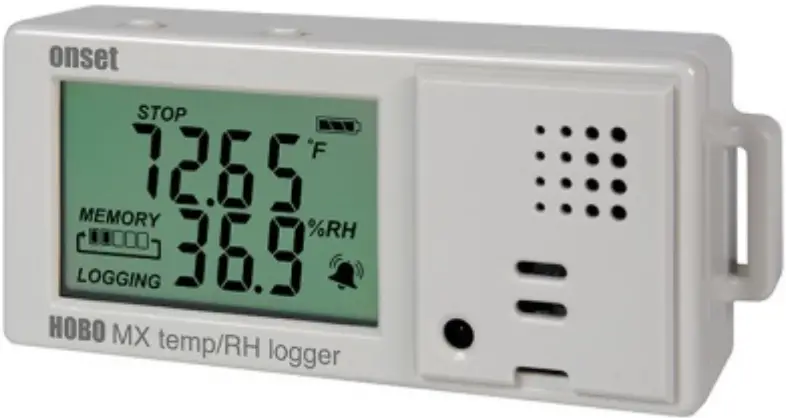
Boitsebiso ba Bohlokoa
Lintho tse Kenyelelitsoeng:
- Command™ strip
- Theipi e mahlakoreng a mabeli
- Hook & loop strap
- Libetri tse peli tsa alkaline tsa AAA 1.5 V
Lintho tse Hlokehang:
- HOBOmobile app
- iPhone, iPod touch, or iPad with iOS 7.1 or later and Bluetooth 4.0 or later
The HOBO MX Temp/RH data logger records and transmits temperature and relative humidity (RH) in indoor environments with its integrated sensors. This Bluetooth® Smart-enabled logger is designed for wireless communication with an iPhone®, iPod touch®, or iPad®. Using the HOBOmobile™ app for iOS, you can easily configure the logger, read it out, and view data on your mobile device, or export the data for further analysis. The logger can calculate minimum, maximum, average, and standard deviation statistics and be configured to trip audible or visual alarms at thresholds you specify. The logger also supports burst logging in which data is logged at a different interval when sensor readings are above or below certain limits. This compact data logger also has a built-in LCD screen to display the current temperature, relative humidity, logging status, battery use, memory consumption, and more.
Litlhaloso
| Sensora ea Mocheso | |
| Range | -20° ho ea ho 70°C (-4° ho ea ho 158°F) |
| Ho nepahala | ± 0.21 ° C ho tloha 0 ° ho isa ho 50 ° C (± 0.38 ° F ho tloha 32 ° ho isa ho 122 ° F), bona Plot A |
| Qeto | 0.024 ° C ho 25 ° C (0.04 ° F ho 77 ° F), bona Plot A |
| Ho hoholeha | <0.1 ° C (0.18 ° F) ka selemo |
| Sensor ea RH | |
| Range | 1% ho isa ho 90% |
| Ho nepahala | ±2% from 20% to 80% typical at 25°C (77°F), see Plot B |
| Hysteresis | ± 2% RH |
| Qeto | 0.01% ho 25°C (77°F) |
| Ho hoholeha | <1% ka selemo e tloaelehileng |
| Nako ea Karabelo | |
| Mocheso | 7:30 minutes in air moving 1 m/s (2.2 mph) |
| RH | Metsotsoana e 20 ho isa ho 90% moea o phallang oa 1 m / s (2.2 mph) |
| Serengoa | |
| Matla a Radio | 1 mW (0 dBm) |
| Phetiso Range | Hoo e ka bang 30.5 m (100 ft) line-of-sight |
| Sesebelisoa sa data se se nang mohala | Bluetooth Smart (Bluetooth Low Energy, Bluetooth 4.0) |
| Palo ea Ts'ebetso ea Logger | -20° to 70°C (-4° to 158°F); 0 to 95% RH (non-condensing) |
| Sekhahla sa ho rema lifate | Motsotsoana o le 1 ho isa ho lihora tse 18 |
| Mekhoa ea ho rema lifate | Nako e tsitsitseng (e tloaelehileng, lipalo-palo) kapa ho phatloha |
| Mekhoa ea Memori | Qetella ha o tletse kapa emisa ha o tletse |
| Qala mekhoa | Hanghang, tobetsa konopo, letsatsi & nako, kapa nako e latelang |
| Emisa mekhoa | Ha memori e tletse, tobetsa konopo, letsatsi le nako, kapa ka mor'a nako e behiloeng ea ho rema lifate |
| Qala bocha Mokhoa | Tobetsa konopo |
| Ho Nepaha ha Nako | ±1 minute per month at 25°C (77°F), see Plot C |
| Bophelo ba Battery | Selemo sa 1, se tloaelehileng ka karohano ea ho rema lifate ea motsotso o le mong. Ho rema lifate kapele le / kapa lipalo-palo sampling intervals, entering burst logging mode, and remaining connected with HOBOmobile will impact battery life. Excessive readouts, checking of Full Status Details, audible alarms, and paging all impact battery life. Visual alarms and other events can have a marginal impact on battery life. |
| Mofuta oa Leshala | Two AAA 1.5 V alkaline batteries, user replaceable |
| Mohopolo | 128 KB (litekanyo tse 84,650, boholo) |
| Nako e Tletseng ea Download Download | Hoo e ka bang metsotsoana e 60; e ka nka nako e telele ho feta ha sesebelisoa se tsoa ho logger |
| LCD | LCD e bonahala ho tloha ho 0 ° ho isa ho 50 ° C (32 ° ho isa ho 122 ° F); LCD e kanna ea sebetsa butle kapa ea fifala maemong a batang kantle ho sebaka sena |
| Boholo | 3.66 x 8.48 x 2.29 cm (1.44 x 3.34 x 0.9 in.) |
| Boima ba 'mele | 56 g (1.98 oz) |
| Tikoloho Rating | IP50 |
 |
Letšoao la CE le supa sehlahisoa sena se latela litaelo tsohle tse amehang ho European Union (EU). |
| Bona leqephe la ho qetela | |
Plot A: Ho nepahala ha mocheso le tharollo
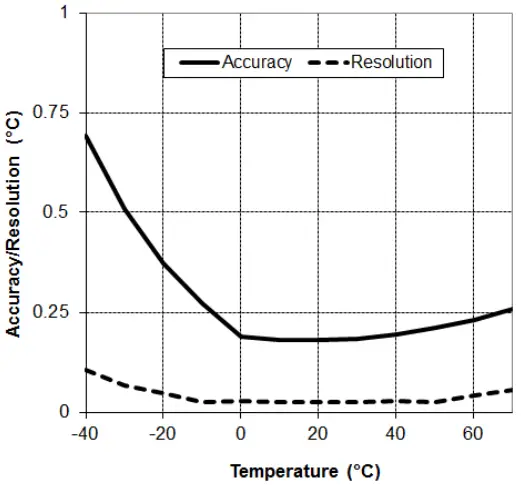
Plot B: Typical RH Accuracy
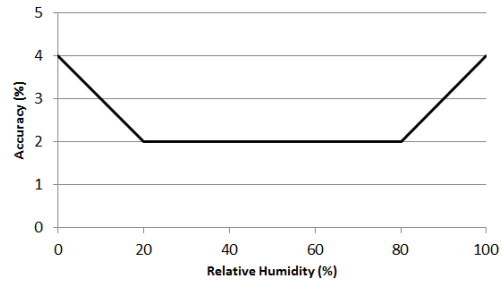
Plot C: Ho Nepaha ha Nako
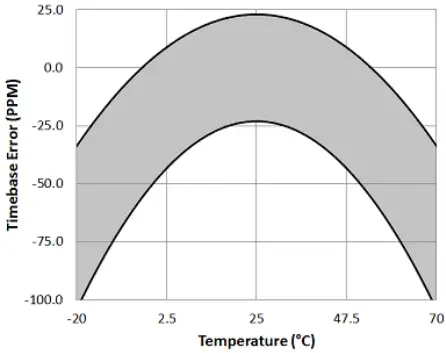
Logger Components And Operation
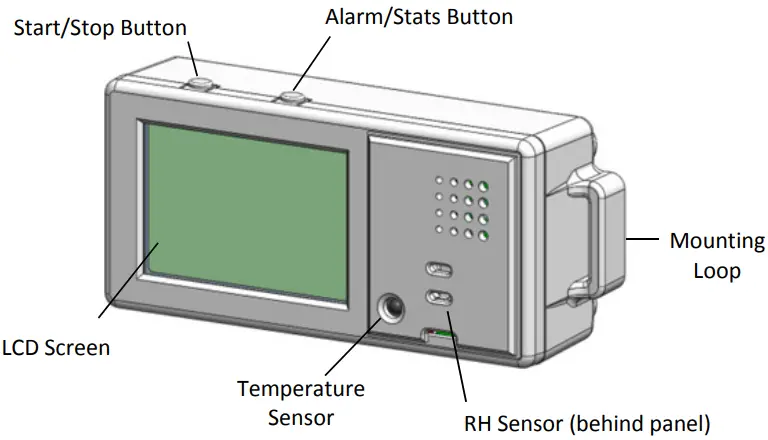
Konopo ea ho qala / ho emisa: Press this button for 3 seconds to start or stop logging data, or to resume logging on the next even logging interval. This requires configuring the logger in HOBOmobile with a push button start or stop, and with Allow Button Restart selected (see Setting up the Logger). You can also press this button for 1 second to record an internal event (see Recording Internal Logger Events), to silence a beeping alarm (see Setting up Alarms), or to turn the LCD screen on if the option to turn off the LCD has been enabled (see Setting up the Logger).
Tobetsa konopo ea Qala / Emisa le konopo ea Alamo / Stats ka nako e le 'ngoe bakeng sa metsotsoana e 3 ho seta password ea logger bocha.
Konopo ea alamo / lintlha: Press this button for 1 second to switch between statistics, alarm readings, and the current sensor readings as applicable or to silence a beeping alarm. Press this button for 3 seconds to clear a visual alarm if the logger was configured in HOBOmobile to maintain the visual alarm until
the alarm button was pressed (see Setting up Alarms).
Ntseng bo eketseha Loops: Sebelisa li-loops tse peli tse hloahloang (e le 'ngoe feela e bonahalang setšoantšong) ho beha logger ka strap ea hook-and-loop (bona Mounting the Logger).
Sensora ea Mocheso: This sensor is located in the lower left corner of the raised panel to the right of the LCD screen.
Sensor ea RH: This sensor is located behind the vented panel in the logger case to the right of the LCD screen and the temperature sensor.
LCD skrine: Logger ena e na le skrine ea LCD e bonts'ang lintlha ka boemo ba hajoale. Mohlankana enoa oa mehlengample bontša matšoao ohle a bonesitsoeng skrineng sa LCD a lateloa ke litlhaloso tsa letšoao ka leng tafoleng e leqepheng le latelang.
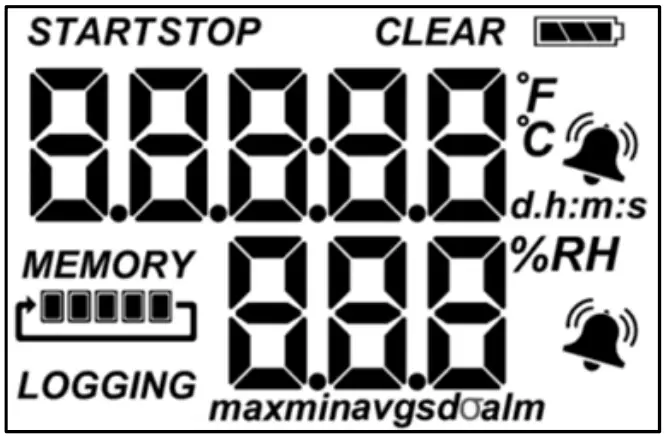
| Letšoao la LCD | Tlhaloso |
| The logger is waiting to be started or restarted. Press and hold the Start/Stop button for 3 seconds to start the logger. |
|
| The logger has been started with push button stop enabled; press and hold the Start/Stop button for 3 seconds to stop the logger. | |
| Letshwao la betri le bontsha hore na ke matla afe a betri a setseng. | |
 |
The logger has been configured to stop logging when memory fills. The memory bar indicates the approximate space remaining in the logger to record data. When first started, all five segments in the bar will be empty. In this example, memori ea logger e se e batla e tletse (karolo e le 'ngoe feela ka har'a bara ea memori ha e na letho). |
 |
The logger has been configured to never stop logging (wrapping). The logger will continue recording data indefinitely, with newest data overwriting the oldest data until the batteries die or the logger is reconfigured. When first launched, all five segments in the memory bar will be empty. Ho sena mohlalaampmemori e tletse (likarolo tsohle tse hlano li tlatsitsoe) mme data e ncha e se e hlakola data ea khale ka ho fetesisa. Sena se tla tsoelapele ho fihlela logger e emisoa kapa betri e felile. |
| Logger hajoale e ntse e rema lifate. | |
 |
A sensor reading is above or below the high or low alarm limit that you configured. Press and release the Alarm/Stats button until the “alm” symbol (described below) is displayed on the screen. This symbol at left will clear depending on how visual alarms were configured in HOBOmobile. If the visual alarm was set to clear when the logger is reconfigured, this symbol will remain on the LCD until the next time new configure settings are loaded onto the logger (see Setting up the Logger). Otherwise, it will clear when the sensor reading is back within the alarm limits or by pressing the Alarm/Stats button for 3 seconds. |
| A visual alarm is ready to be cleared. This will only appear if HOBOmobile was configured to maintain the visual alarm until the alarm button is pressed. Press the Alarm/Stats button for 3 seconds to clear the visual alarm. Note that an audible alarm can be silenced by pressing the Start/Stop button or Alarm/Stats button for 1 second. |
|
 |
These symbols show the maximum, minimum, average, and standard deviation values most recently calculated by the logger (if the logging mode has been set to Fixed Interval in HOBOmobile and each statistic has been selected; see Statistics Logging). Press the Alarm/Stats button for 1 second to cycle through the available statistics and then back to the current sensor reading (or to the alarm value if applicable). |
| This is the farthest out-of-range sample displayed during the logger deployment. Press the Alarm/Stats button to view ho bala hona. Tobetsa konopo ea Alarm / Stats hape ho potoloha lipalo-palo life kapa life (tse hlalositsoeng kaholimo) ebe qetellong u khutlela ho bala ea senotlolo ea hajoale. | |
 |
Ena ke example ea ho bala mocheso. Temperature units are determined by the settings in HOBOmobile. To switch between Celsius and Fahrenheit, change the units in the HOBOmobile Settings (the logger must be reconfigured for units changes to take effect). |
 |
Ena ke example ea ho bala RH. |
 |
Logger e hlophiselitsoe ho qala ho rema lifate ka nako / nako e itseng. Pontšo e tla baloa ka matsatsi, lihora, metsotso le metsotsoana ho fihlela ho rema lifate ho qala. Ho ex enaample, metsotso e 5 le metsotsoana e 38 e setse ho fihlela ho rengoa ha lifate ho tla qala. |
| The configure settings are being loaded onto the logger from HOBOmobile. | |
 |
An error occurred while loading the configure settings onto the logger from HOBOmobile. Try reconfiguring the logger. |
 |
The logger has been stopped with HOBOmobile or because the memory is full. |
Lintlha:
- U ka tima skrine ea LCD ha u rema lifate. Tlosa khetho ea "Show LCD" ha u theha logger joalo ka ha ho hlalositsoe karolong e latelang. Ha khetho ena e koetsoe, u ntse u ka khona ka nakoana view skrine ea LCD ka ho tobetsa konopo ea Start / Stop motsotsoana o le mong. LCD e tla lula metsotso e 1.
- The LCD screen refreshes every 15 seconds regardless of the logging interval selected in HOBOmobile. If you choose a logging interval less than 15 seconds, the data will be recorded at the faster interval, but the sensor readings will only be updated on the screen every 15 seconds.
- When the logger has stopped logging, the LCD screen will remain on with “STOP” displayed until the logger is offloaded to your mobile device (unless the logger was configured with the “Show LCD” option disabled). Once the logger has been offloaded, the LCD will turn off automatically after 2 hours. The LCD will turn back on the next time the logger connects with your device through HOBOmobile.
- The LCD screen flashes “HELLO” when you page the logger from HOBOmobile (see Downloading HOBOmobile and Connecting to a Logger).
- LCD skrine e khantša "CHIRP OFF" ha alamo e utloahalang e tlosoa.
Downloading HOBOmobile And Connecting To A Logger
Kenya sesebelisoa sa HOBOmobile ho hokela le ho sebetsa le sereta.
- Download HOBOmobile. Go to the App Store and download HOBOmobile to your iPhone, iPod touch, or iPad.
- Kenya libeteri. Open the battery door on the back of the logger and insert two AAA batteries observing polarity (see Battery Information). Reinsert the battery door and snap it back into place.
- Bula HOBOmobile. Enable Bluetooth in your device settings if prompted (go to Settings > Bluetooth and make sure it is marked as “On”).
- Hokela ho logger. Tlanya
 . The logger should appear in the Recently Seen/In Range list as shown here.
. The logger should appear in the Recently Seen/In Range list as shown here.

Tap the row in the list to connect to the logger. If it does not appear in the list, make sure the logger is within range of your mobile device. Note that current sensor readings are always visible in this list even if the logger is not logging.
Tips for connecting:
- Etsa bonnete ba hore "logger" e sebakeng se lekaneng le sesebelisoa sa hau sa mohala. Sebaka sa puisano e atlehileng ea waelese e ka ba 30.5 m (100 ft) e nang le mohala o felletseng oa pono.
- Haeba sesebelisoa sa hau se khona ho hokahana le se rekotang nako le nako kapa se lahleheloa ke khokahano ea sona, atamela haufi le se remang lifate, moo u se bonang ha ho khoneha.
- If the logger appears in the Recently Seen/In Range list, but you cannot connect to it, close HOBOmobile and power cycle the mobile device. This forces the previous Bluetooth connection to close.
Hang ha o hokahane le logger o ka khetha e 'ngoe ea liketso tse latelang:
- Hlophisa. Select logger settings and load them onto the logger to start logging. See Setting up the Logger.
- Readout. Offload logger data. See Reading Out the Logger.
- Full Status Details. Check the battery level and view litlhophiso tsa tlhophiso tse khethiloeng hajoale bakeng sa logger.
- Start Logging or Restart Logging. These options appear depending on the Start Logging and Stop Logging settings selected in the next section.
- Emisa ho rema lifate. Stop the logger from recording data (this overrides any Stop Logging settings described in Setting up the Logger).
- Page. Press and hold the Page icon and the logger will beep to help you locate a deployed logger (tap the Page icon if you only want the logger to beep once). “HELLO” also appears on the LCD when the logger is paged.
- Clear Audible Alarm. If audible alarms are enabled as described in Setting up Alarms, use this to clear a beeping alarm on the logger.
- Logger Password. Select this to create a password for the logger that will be required if another mobile device attempts to connect to it. To reset a password, simultaneously press both the Start/Stop button and the Alarm/Stats button on the top of the logger for 3 seconds or tap Reset to Factory Default in the Set Logger Password screen.
- Ntlafatsa Firmware. When new logger firmware is available, this action appears in the list. Select it and follow the instructions on the screen. Note that if there is a communication failure during the firmware update process, the logger will revert to the previous firmware.
- Force Offload. This may appear if an error was encountered when loading configure settings. Select this to offload all the data on the logger before reconfiguring the logger.
Setting Up The Logger
Use HOBOmobile to set up the logger, including setting alarms, selecting the options to start and stop logging, and choosing a logging mode. These steps provide an overview of setting up the logger. For complete details, see the HOBOmobile User’s Guide.
- Tlanya
 and select a logger in the Recently Seen/In Range list to connect to it.
and select a logger in the Recently Seen/In Range list to connect to it. - Hang ha o hokahane, tlanya Configure.

- Tap Label and type a name for the logger up to 20 characters (optional). Tap Done.
- Tlanya Sehlopha ho kenya ralithara sehlopheng sa Favorites, sehlopha se seng se ntse se le teng, kapa ho theha lebitso la sehlopha le lecha le nang le litlhaku tse fihlang ho 20 (ka boikhethelo). Tlanya Qetile.
- Tlanya "Start Logging" 'me u khethe ha ho rema lifate ho tla qala:
- Jwale. Ho rengoa ha lifate ho tla qala hang ka mor'a ho tlanya Qala skrineng sa Configure.
- Nako e latelang ea ho rema lifate. Ho rengoa ha lifate ho tla qala ka nako e latelang le ho latela karohano e khethiloeng ea ho rema lifate.
- Ka konopo ea Push. Logging will begin once you press the Start/Stop logging button on the logger for 3 seconds.
- Ka Letsatsi / Nako. Logging will begin at a date and time you specify. Select the Date and time Tap Done.
- Tlanya Stop Logging ebe u khetha likhetho tsa hore na ho rema lifate ho tla fela neng.
a. Khetha e 'ngoe ea likhetho tse peli tsa memori:- Ha Memori e Tlatsa. Setsebi se tla tsoela pele ho rekota data ho fihlela memori e tletse.
- Le ka mohla (thatela ha o tletse). Setsebi se tla tsoela pele ho rekota data ka ho sa feleng, 'me data e ncha e tla ngola ea khale ka ho fetesisa. Khetho ena ha e fumanehe haeba Mokhoa oa ho Rema lifate o setetsoe ho Burst (sheba Burst Logging).
b. Select On Button Push if you want to be able to stop logging by pushing the Start/Stop button on the logger for 3 seconds. Note that if you also choose On Button Push for the Start Logging option, then you will not be able to stop logging until 30 seconds after logging begins.
If you select On Button Push for the Stop Logging option, then you also have the option to select Allow Button Restart. This allows you to stop and then resume logging during the deployment by pushing the Start/Stop button on the logger for 3 seconds.
Bohlokoa: When Allow Button Restart is selected and you use the Start/Stop button to stop and restart logging, logging will restart on the next even logging interval, not at the time the button was pushed. For example, a logger started logging at 7:00 AM with a logging interval set to 1 hour. If you press the Start/Stop button to stop the logger at 8:45 AM and then press the button again at 10:15 AM, logging will not begin immediately at 10:15 AM. Instead, logging will begin again at 11:00 AM, which is the next even interval time based on your 1-hour logging interval.
Therefore, depending on the logging interval, the gap between the time you press the button to resume logging and the time actual logging begins could be significant. The faster the logging interval, the less time will elapse before logging resumes.
c. Khetha e 'ngoe ea likhetho tse latelang tsa nako ea ho emisa ho rema lifate: - Le ka mohla. Khetha sena haeba u sa batle hore motho ea remang lifate a emise ka nako efe kapa efe e reriloeng esale pele.
- Ka Letsatsi / Nako. Select this if you want the logger to stop logging on a specific date and time. Select the date and time and then tap Done.
- Kamora. Select this if you want to control how long the logger should continue logging once it starts. Choose the amount of time you want the logger to log data and then tap Done. For example, khetha matsatsi a 30 haeba u batla hore motho ea remang lifate a kenelle data bakeng sa matsatsi a 30 ka mor'a hore ho rema lifate ho qale.
d. Tlanya Qetile.
- Khetha mefuta ea litekanyo tsa sensor tse tla kenngoa.
By default, both the temperature and RH sensors are enabled. Both sensors are required to calculate dew point, which is an additional data series available for plotting after reading out the logger. You can also set up alarms to trip when a sensor reading rises above or falls below a specified value. See Setting up Alarms for details on enabling sensor alarms and selecting the associated audible and visual alarm settings. - Tap Logging Mode. Select either fixed interval logging or burst logging. With fixed interval logging, the logger records data for all enabled sensors and/or selected statistics at the logging interval selected (see Statistics Logging for details on choosing statistics options). In burst mode, logging occurs at a different interval when a specified condition is met. See Burst Logging for more information. Tap Done.
- Enable or disable Show LCD, which controls whether the LCD on the logger will remain illuminated while the logger is logging. If you disable Show LCD, the LCD on the logger will not show the current reading, status, or other information while the logger is logging. You will, however, be able to
temporarily turn the LCD screen on by pressing the Start/Stop button on the logger for 1 second. In addition, you can always view boemo ba "logger" efe kapa efe sesebedisweng sa hao sa selefounu ho sa tsotelehe maemo a LCD a LCD (e ka hloka password ya logger kamoo e sebetsang). - Tap Start in the upper right corner of the Configure screen to load the settings onto the logger if you are ready to start.

Logging will begin based on the settings you selected.
Deploy the logger using the mounting materials (see Mounting the Logger). After logging begins, you can read out the logger at any time (see Reading Out the Logger for details).
Setting Up Alarms
O ka seta alamo hore e khoptjoe ke logger ha ho bala hoa sensor ho phahama kapa ho oela ka tlase ho boleng bo boletsoeng. Sena se ka o hlokomedisa ka mathata hore o tle o tsebe ho lokisa. Ho seta alamo:
- Tlanya
 and select a logger in the Recently Seen/In Range list to connect to it.
and select a logger in the Recently Seen/In Range list to connect to it. - Hang ha o hokahane, tlanya Configure.
- In Sensor & Alarm Setup, tap an enabled sensor.
- Enable the High Alarm if you want an alarm to trip when the sensor reading rises above the high alarm value. Drag the slider to the reading that will trip the alarm or tap the value field and type a specific reading. In this example, alamo e tla khoptjoa ha mocheso o nyolohela ka holimo ho 85°F.
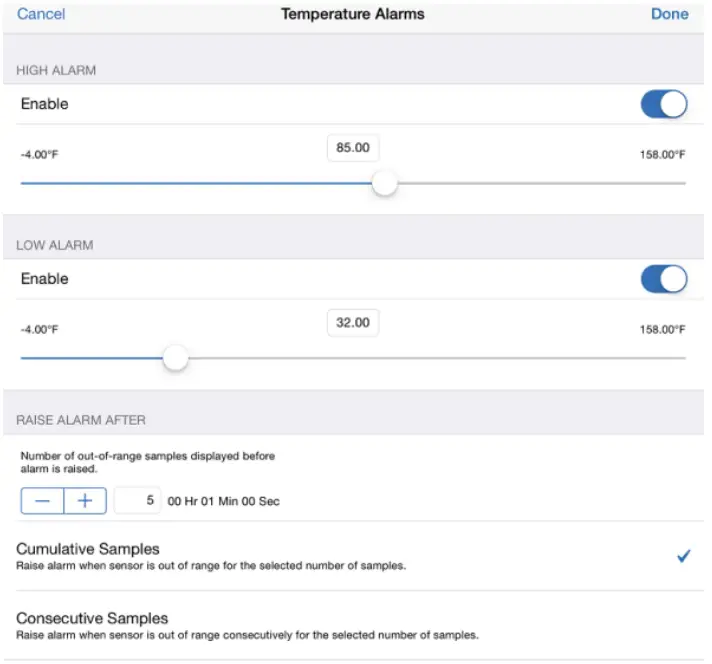
- Lumella Alamo e Tlaase haeba u batla hore alamo e khoephe ha 'malo oa sensor o oela ka tlase ho boleng bo tlase ba alamo. Hulela selaete 'malong se tla khopa alamo kapa u tobetse karolo ea bohlokoa ebe u ngola 'malo o itseng. Ka mohlalaampLe, alamo e lokiselitsoe hore e khoephe ha mocheso o theohela ka tlase ho 32°F.
Hlokomela: Litekanyetso tsa sebele bakeng sa meeli ea alamo e phahameng le e tlaase e behiloe ho boleng bo haufi-ufi bo tšehetsoeng ke logger. - Under Raise Alarm After, select how many out-of-range samples are needed to trigger the alarm. For example, if Raise Alarm After is set to 5 as shown above, then there needs to be 5 sensor readings above 85°F or below 32°F before the alarm will trip. The time displayed next to the sample number indicates how long it would take for the alarm to trip based on the number of samples you entered and the fixed 15-second LCD refresh interval.
- Select either Cumulative Samples or Consecutive Samples. Haeba u khetha Cumulative Samples, then the alarm will trip after a specific number of samples are outside the limits at any point during logging. If you select Consecutive Samples, then the alarm will trip after a specific number of samples outside the limits are displayed in a row. For example, if there are 5 readings in a row above 85°F, then an alarm will trip. However, if Cumulative Samples was selected instead, then the 5 readings could have taken place at any time during the deployment for the alarm to trip.
- Tlanya E felile 'me u phete mehato ea 3-8 bakeng sa sensor e' ngoe haeba u lakatsa.
- Back in the Configure screen, enable Audible Alarms if you want a beep to sound on the logger every 30 seconds when the sensor alarm trips. The beeping will continue until the alarm is cleared from HOBOmobile, either button on the top of the logger is pressed, or 7 days have passed. Battery life will be slightly reduced when this setting is enabled. It is recommended that you only enable this feature if you have regular access to the logger so that you can easily turn off the beeping.
- Also in the Configure screen, select one of the following options to determine how long the alarm icon will remain illuminated on the logger LCD screen after an alarm trips:
- Logger Reconfigured. The alarm icon will remain visible on the LCD until the next time the logger is reconfigured.
- Sensor ka Meeli. The alarm icon will remain visible on the LCD until the sensor reading returns to the normal range between any configured high and low alarm limits.
- Alarm Button Pressed. The alarm icon will remain visible until you press the Alarm/Stats button on the logger.
- Tap Start in the Configure screen to load the alarm settings onto the logger if you are ready to start.
Lintlha:
- The alarm icon will be illuminated on the logger LCD when the alarm trips. You can also press the Alarms/Stats button on the logger to view the farthest out-of-range value during the deployment. Alarm limits are checked when the logger’s LCD screen refreshes every 15 seconds.
- Litekanyetso tsa 'nete bakeng sa meeli e phahameng le e tlase ea alamo li behiloe ho boleng bo haufi haholo bo tšehetsoang ke logger. Bakeng sa example, the closest value to 85°F that the logger can record is 84.990°F and the closest value to 32°F is 32.043°F. In addition, alarms can trip or clear when the sensor reading is within the logger specifications of 0.02°C resolution. This means the value that triggers the alarm may differ slightly than the value entered. For examphaeba Alamo e Phahameng e behiloe ho 75.999 ° F, alamo e ka khoptjoa ha sensor ea ho bala e le 75.994 ° F (e kahara qeto ea 0.02 ° C).
- Ha u bala logger, liketsahalo tsa alamo li ka bonts'a morerong kapa ho data file. See Recording Internal Logger Events.
- Once cleared, an audible alarm will start beeping again if the sensor values go out of the normal range. Even if an audible alarm is cleared, a visual alarm may remain on the logger LCD and in HOBOmobile depending on the settings selected for maintaining visual alarms or because the alarm condition may still be in effect. In addition, an audible alarm will continue beeping when the sensor values have returned to the normal range until it is cleared as described in step 9.
- Although an audible alarm and a visual alarm can occur at the same time when a sensor alarm is tripped, they are cleared in different ways. The audible alarm can be cleared as described in step 9. Meanwhile, a visual alarm is cleared as determined by the setting selected for Maintain Visual Alarm Until in the Configure screen. This means you could clear a beeping audible alarm and the visual alarm will remain on the LCD and in HOBOmobile until the logger is reconfigured, the sensor is in limits, or the alarm button is pressed–whichever setting you selected.
- If the logger was configured to stop logging with a button push, any tripped alarms will be cleared automatically when logging is stopped and no Alarm Cleared event will be logged in the data file. This ensures that the logger will start checking for alarm conditions when logging resumes (if the logger was configured with Allow Button Restart selected).
Ho Phunya Lifate
urst logging is a logging mode that allows you to set up more frequent logging when a specified condition is met. For example, a logger is recording data at a 5-minute logging interval and burst logging is configured to log every 30 seconds when the temperature rises above 85°F (the high limit) or falls below 32°F (the low limit). This means the logger will record data every 5 minutes as long as the temperature remains between 85°F and 32°F. Once the temperature rises above 85°F, the logger will switch to the faster logging rate and record data every 30 seconds until the temperature falls back to 85°F.
Ka nako eo, ho rema lifate ho qalella metsotso e meng le e meng e 5 ka nako e tloaelehileng ea ho rema lifate. Ka mokhoa o ts'oanang, haeba mocheso o oela ka tlase ho 32 ° F, joale motho ea remang lifate o tla fetohela ho mokhoa oa ho rema lifate hape ebe o rekota data metsotsoana e meng le e meng e 30. Hang ha mocheso o nyolohela ho 32 ° F, sereta se tla khutlela mokhoeng o tloaelehileng, se rema metsotso e meng le e meng e mehlano.
Hlokomela: Lialamo tsa sensor, lipalo, le khetho ea Stop Logging "Wrap When Full" ha li fumanehe ka mokhoa oa ho rema lifate.
Ho theha "burst regging":
- Tlanya
 and select a logger in the Recently Seen/In Range list to connect to it.
and select a logger in the Recently Seen/In Range list to connect to it. - Hang ha o hokahane, tlanya Configure.
- Tlanya Mokhoa oa ho Logging ebe o tlanya Burst Logging.
- Tlanya sensor tlasa Burst Sensor Limits.
- Numella Meeli e Phahameng haeba u batla ho rema lifate ho etsahala ha 'malo oa sensor o phahama ka holim'a 'malo o itseng. Hulela selaete 'malong se tla etsa hore ho rengoe lifate kapa ho tlanye karolo ea bohlokoa ebe u ngola 'malo o itseng. Ho sena mohlalaample, the logger will switch to burst logging when the temperature rises above 85°F.

- Numella Low Limit haeba u batla ho rema lifate ho etsahala ha 'malo oa sensor o oela ka tlase ho palo e itseng. Hulela selaete 'malong se tla etsa hore ho rengoe lifate kapa ho tlanye karolo ea bohlokoa ebe u ngola 'malo o itseng. Ka mohlalaample, the logger will switch to burst logging when the temperature falls below 32°F.
- Tlanya E felile 'me u phete mehato ea 4-7 bakeng sa sensor e' ngoe haeba u lakatsa.
- Tap Burst Logging Interval and select an interval faster than the logging interval. Keep in mind that the more frequent the burst logging rate, the greater the impact on battery life and the shorter the logging duration. Tap Done.
- Tlanya Qetello ho tsoa skrineng sa Mokhoa oa ho Reka.
- Tlanya Qala skrineng sa Configure ho kenya li-setting tsa ho phatloha ho logger haeba u se u loketse ho qala.
Lintlha:
- Once the logger is configured, the high and low burst limits are only checked when the logger’s LCD screen refreshes once every 15 seconds. Therefore, if you set the logging interval to less than 15 seconds and the sensor reading falls outside the levels, the burst logging will not begin until the next 15-second refresh cycle.
- Haeba meeli e phahameng le / kapa e tlase e lokiselitsoe ho sensor e fetang e le 'ngoe, joale ho rema lifate ho tla qala ha boemo leha e le bofe bo phahameng kapa bo tlaase bo tsoa. Ho rema lifate ho ke ke ha fela ho fihlela maemo ohle a li-sensor tsohle a khutletse ka har'a sebaka se tloaelehileng.
- Litekanyetso tsa 'nete bakeng sa meeli e phatlohileng ea ho rema lifate li behiloe ho boleng bo haufi haholo bo tšehetsoang ke logger. Bakeng sa example, boleng bo haufi ka ho fetisisa ho 85 ° F boo logger a ka bo rekotang ke 84.990 ° F mme boleng bo haufi ho 32 ° F ke 32.043 ° F.
- Burst logging mode can begin or end when the sensor reading is within the logger specifications of 0.02°C resolution. This means the value that triggers burst logging may differ slightly than the value entered. For exampha, haeba moeli o phahameng oa alamo ea mocheso o behiloe ho 75.999 ° F, ho rema lifate ho ka qala ha senotlolo sa kutlo se le 75.994 ° F (se kahara qeto ea 0.02 ° C).
- Hang ha boemo bo phahameng kapa bo tlase bo hlaka, nako ea ho rema lifate e tla baloa ho sebelisoa lintlha tsa hoqetela tse tlalehiloeng ka mokhoa o phatlohileng oa ho rema lifate, eseng ntlha ea hoqetela ea data e tlalehiloeng ka "mokhoa o tloaelehileng." Bakeng sa exampJoale, ha re nkeng hore logger e na le nako ea ho rema lifate ka metsotso e 10 mme e kentse ntlha ea data ho 9:05. Eaba moeli o moholo o fetiloe mme ho pongoa ha lifate ho qalile ka 9:06. Ho rema lifate ka bohale ho ile ha tsoela pele ho fihlela 9: 12 ha ho bala ha sensor ho oele morao ka tlase ho moeli o phahameng. Hona joale e se e khutlile ka mokhoa o tloaelehileng, nako e latelang ea ho rema lifate e tla ba metsotso e 10 ho tloha moo ho rengoeng lifate ka lekhetlo la ho qetela, kapa 9:22 ntlheng ena. Haeba ho rema lifate ka sekhahla ho ne ho sa etsahala, ntlha e latelang ea data e ka be e le ka 9:15.
- A New Interval event is created each time the logger enters or exits burst logging mode. See Recording Internal Logger Events for details on plotting and viewing the event. In addition, if the logger is stopped with a button push while in burst logging mode, then a New Interval event is automatically logged and the burst condition is cleared, even if the actual high or low condition has not cleared. The logger will check the high and low conditions when logging resumes (if the logger was configured with Allow Button Restart selected).
Ho rema lifate tsa lipalo-palo
Nakong ea ho rema lifate ka nako e sa lekanyetsoang, logger e tlaleha lintlha tsa li-sensor tse nolofalitsoeng le / kapa lipalo-palo tse khethiloeng nakong ea ho rema lifate e khethiloeng. Lipalo-palo li baloa ho ea kaampling rate o bolela ka liphetho tsa sampnako e rekotiloeng ka nako e 'ngoe le e 'ngoe ea ho rema lifate. Lipalo-palo tse latelang li ka kenngoa bakeng sa sensor ka 'ngoe:
- Boholo, kapa bo phahameng ka ho fetisisa, sampled value,.
- Bonyane, kapa tlase ka ho fetisisa, sampled value,.
- Karolelano ea tsohle sampled values, and.
- Ho kheloha ho tloaelehileng ho tloha ho karolelano ea bohle samplitekanyetso tse etelletsoeng pele.
Bakeng sa mohlalaample, a logger is configured with both the temperature and RH sensors enabled, and the logging interval set to 5 minutes. The logging mode is set to fixed interval logging with Normal and all four statistics enabled and with a statistics sampnako e telele ea metsotsoana e 30. Hang ha ho rema lifate ho qala, moqapi o tla lekanya le ho rekota mocheso oa 'nete le boleng ba sensor ea RH metsotso e meng le e meng e 5. Ho phaella moo, logger tla nka mocheso le RH sample metsotsoana e meng le e meng e 30 ebe u li boloka ka sehopotso ka nakoana. Logger e tla bala boholo, bonyane, karolelano le kheloho e tloaelehileng ba sebelisa sampLes li bokelletsoe nakong ea metsotso e 5 e fetileng ebe li kenya litekanyetso. Ha u bala logger, sena se ka fella ka letoto la lintlha tse 10 (ho sa kenyeletsoe lethathamo la lintlha tse tsoang, joalo ka phoka): letoto la li-sensor tse peli (ka mocheso le data ea RH e kentsoeng metsotso e meng le e meng e 5) hammoho le boholo bo robeli, bonyane, karolelano le maemo Letoto la ho kheloha (tse 'ne bakeng sa mocheso le tse' ne bakeng sa RH ka litekanyetso tse baloang le ho kena metsotso e meng le e meng e 5 ho ipapisitsoe le metsotsoana e 30ampLing).
Ho boloka lipalo-palo:
- Tlanya
 and select a logger in the Recently Seen/In Range list to connect to it.
and select a logger in the Recently Seen/In Range list to connect to it. - Hang ha o hokahane, tlanya Configure.
- Tlanya Mokhoa oa ho Rema 'me u khethe ho Rengoa ha Nako e Tsitsitseng.
- Khetha Tloaelehileng ho rekota 'malo oa hajoale bakeng sa sensor e' ngoe le e 'ngoe e lumelletsoeng nakong ea ho rema lifate e bonts'itsoeng kaholimo ho skrini. Se ke oa khetha sena haeba feela u batla ho ngola lipalo-palo.
- Khetha lipalo-palo tseo u batlang hore logger e li tlalehe ka nako e 'ngoe le e' ngoe ea ho rema lifate: Boholo, Bonyane, Karolelano le Phapanyetso e Tloaelehileng (karolelano e lumelloa ka bo eona ha u khetha kheloho e tloaelehileng). Lipalo-palo li tla kenngoa bakeng sa lisele tsohle tse lumelloang. Ntle le moo, lipalo-palo tse ngata tseo u li tlalehang, li khutsufatsa nako ea logger le mohopolo o eketsehileng oa hlokahala.
- Tlanya Lipalo-palo Sampling Nako ebe u khetha sekhahla seo u ka se sebelisang ho bala lipalo-palo. Sekhahla se tlameha ho ba tlase ho, le ntlha ea, nako ea ho rema lifate. Bakeng sa mohlalaample, haeba nako ea ho rema lifate e le motsotso o le mong ebe u khetha metsotsoana e 1 bakeng sa sampling rate, joale logger o tla nka 12 sample ho bala lipakeng tsa nako e 'ngoe le e 'ngoe ea ho rema lifate (sampLe metsotsoana e meng le e meng e 5 ka motsotso) 'me u sebelise metsotsoana e 12ampLes ho rekota lipalo-palo tse hlahisoang ka nako e 'ngoe le e' ngoe ea ho rema lifate. Hlokomela hore hangata sampsekhahla sa puo, matla a maholo bophelong ba betri.
- Tlanya Qetile.
- Tlanya Qetile hape ho tsoa skrineng sa Mokhoa oa ho Reka.
- Tlanya Qala skrineng sa Configure ho kenya li-setting tsa lipalo-palo ho logger haeba u se u loketse ho qala.
Once logging begins, click the Alarm/Stats button on the logger to cycle through the current maximum, minimum, average, and standard deviation data on the LCD screen. Note that the logger will always display the current sensor readings in HOBOmobile even if they are not being logged. You can plot the statistics series once you read out the logger.
Reading Out The Logger
Ho theola data ho tsoa ho logger:
- Tlanya
 .
. - Find the logger you wish to offload in the Recently Seen/In Range list and tap that row.
- Once connected, tap Readout.
- Tlanya
 ho view a mini-graph of the offloaded data.
ho view a mini-graph of the offloaded data. - Tlanya mini-graph ho view mofuta o moholo oa kerafo kapa ho arolelana file.
See the HOBOmobile User’s Guide for details on viewing graphs and sharing data.
Ho rekota Liketsahalo tsa Logger tse ka hare
The logger records the following internal events to track logger operation and status. To plot events in HOBOmobile, tap a mini-graph and then tap ![]() . Select the events you wish to plot and then tap
. Select the events you wish to plot and then tap ![]() again. You can also view diketsahalo ho data e arolelanoeng kapa e rometsoeng kantle ho naha files.
again. You can also view diketsahalo ho data e arolelanoeng kapa e rometsoeng kantle ho naha files.
| Lebitso la Ketsahalo le ka Hare | Tlhaloso |
| Motsamaisi o hoketsoe | Logger e ne e hokahane le sesebelisoa sa mohala. |
| E qadile | The Start/Stop button was pressed to begin or resume logging. |
| E emisitsoe | The logger received a command to stop recording data (from HOBO mobile or by pushing the Start/Stop button). |
| Button Up / Button Tlase | Konopo ea Start / Stop e ile ea hatelloa motsotsoana o le mong. |
| Alarm e khopiloe | A sensor alarm has tripped; <#> is the sensor number, where 1 is temperature and 2 is RH. |
| Alamo e hlakotsoe | A sensor alarm has cleared; <#> is the sensor number, where 1 is temperature and 2 is RH. This event also contains the value that was furthest out of range for the sensor before the alarm cleared, which is only available in a shared or exported file. |
| Nako e Ncha | Logger e kentse kapa ea tsoa ka mokhoa o phatlohileng oa ho rema lifate. |
| Sireletsehile Shutdown | Boemo ba betri bo theohile ka tlase ho 2.5 V; logger e etsa shutdown e sireletsehileng. |
Mounting The Logger
Ho na le mekhoa e mengata ea ho kenya logger u sebelisa lisebelisoa tse kenyellelitsoeng:
- Sebelisa limakenete tse 'ne tse ka morao ho mokotla oa logger ho e beha sebakeng sa makenete.
- Hokela likhoele tsa Taelo ka morao ho sereta ho se hloma leboteng kapa sebaka se seng se bataletseng. Phahamisa mela e 'meli ea Taelo e le hore e hlahelle ho feta limakenete.
- Sebelisa theipi e mahlakore a mabeli ho maneha logger holimo.
- Kenya lebanta la hakisi le hakisi ho pholletsa le likonopo tse hloahloang ka mahlakore ka bobeli a logger ho e beha holima bokaholimo, joalo ka phala kapa tubing.
Protecting The Logger
Logger e etselitsoe ts'ebeliso ea ka tlung mme e ka senyeha ruri ke ts'enyeho haeba e koloba. E sireletse ho condensation. Haeba molaetsa FAIL CLK o hlaha skrineng sa LCD, ho bile le ho hloleha ka oache ea kahare ea logger mohlomong ka lebaka la condensation. Tlosa betri hang-hang 'me u omise boto ea potoloho.
Hlokomela: Motlakase o tsitsitseng o ka etsa hore motho ea remang lifate a khaotse ho rema lifate.
Logger e 'nile ea lekoa ho 8 KV, empa u qobe ho tsoa ha motlakase ka ho itšireletsa ho sireletsa logger. Bakeng sa tlhaiso-leseling e batsi, batla "static discharge" ho qalacomp.com.
Lintlha tsa Battery
Logger e hloka li-alkaline tsa AAA 1.5 V tse sebelisang motho e mong tse ka sebelisoang kapa tse khetholloang bakeng sa tšebetso bakeng sa ts'ebetso lipheletsong tse fetelletseng tsa mofuta oa logger. Bophelo bo lebelletsoeng ba betri bo ea fapana ho latela thempereichara e sebakeng seo logger e romelloang ho sona, ho rengoa ha lifate kapa sampkarohano ea nako, khafetsa ea ho theola le ho hokela sesebelisoa sa mohala, palo ea likanale tse sebetsang, nako ea lialamo tse utloahalang, tšebeliso ea mokhoa oa ho phatloha kapa ho rekota lipalo, le ts'ebetso ea betri. Libetri tse ncha hangata li nka selemo se le 1 ka linako tsa ho rema lifate tse fetang motsotso o le mong. Ho tsamaisoa ka mocheso o batang haholo kapa o chesang haholo, nako ea ho rema lifate ka potlako ho feta motsotso o le mong, kapa joalo kaampNako ea ling ka potlako ho feta metsotsoana e 15 e ka ama bophelo ba betri. Likhakanyo ha li netefatsoe ka lebaka la ho se ts'oanehe maemong a betri ea pele le tikolohong ea ts'ebetso.
Ho kenya kapa ho khutlisa libeteri:
- Bula lemati la betri ka morao ho logger.
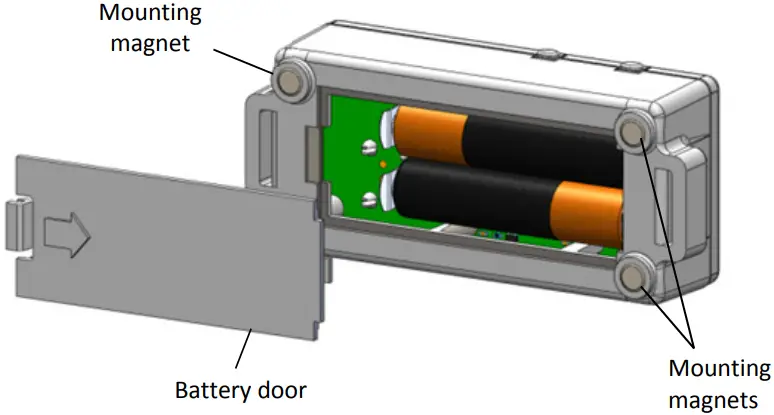
- Tlosa libeteri tsa khale.
- Kenya libeteri tse peli tse ncha tse shebileng polarity.
- Kenya monyako oa betri hape ebe oe khutlisetsa sebakeng sa eona.
![]() TLHOKOMELISO: Se ke oa bula, oa chesa, mocheso o ka holimo ho 85°C (185°F), kapa ua nchafatsa libeteri tsa lithium. Libetri li ka 'na tsa phatloha haeba serepa se ka pepesehela mocheso o feteletseng kapa maemo a ka senyang kapa a senya mokotla oa betri. U se ke ua lahla rakota kapa libeteri mollong. Se ke oa pepesa litaba tsa libeteri metsing. Lahla libeteri ho latela melao ea lehae bakeng sa libeteri tsa lithium.
TLHOKOMELISO: Se ke oa bula, oa chesa, mocheso o ka holimo ho 85°C (185°F), kapa ua nchafatsa libeteri tsa lithium. Libetri li ka 'na tsa phatloha haeba serepa se ka pepesehela mocheso o feteletseng kapa maemo a ka senyang kapa a senya mokotla oa betri. U se ke ua lahla rakota kapa libeteri mollong. Se ke oa pepesa litaba tsa libeteri metsing. Lahla libeteri ho latela melao ea lehae bakeng sa libeteri tsa lithium.
Tlhaloso ea Fcc
Federal Communication Commission Statement
Thepa ena e lekiloe 'me e fumanoe e lumellana le meeli ea sesebelisoa sa digital sa Sehlopha sa B, ho latela Karolo ea 15 ea Melao ea FCC. Meeli ena e etselitsoe ho fana ka tšireletso e utloahalang khahlanong le tšitiso e kotsi mohahong oa bolulo. Thepa ena e hlahisa tšebeliso 'me e ka khantša matla a maqhubu a seea-le-moea, 'me haeba e sa kengoa le ho sebelisoa ho latela litaelo, e ka baka tšitiso e kotsi likhokahanong tsa radio. Leha ho le joalo, ha ho na tiiso ea hore tšitiso e ke ke ea etsahala setsing se itseng. Haeba sesebelisoa sena se baka tšitiso e kotsi ho kamohelo ea seea-le-moea kapa ea thelevishene, e ka khethoang ka ho tima le ho tima sesebelisoa, mosebelisi o khothalletsoa ho leka ho lokisa tšitiso ka e 'ngoe ea mehato e latelang:
- Sheba hape kapa o suthise lenakana le amohelang sebakeng se seng
- Eketsa karohano pakeng tsa thepa le moamoheli
- Hokela lisebelisoa sebakeng sa seketsoana se fapaneng le seo moamoheli a hokahaneng le sona
- Ikopanye le morekisi kapa setsebi sa radio/TV se nang le boiphihlelo bakeng sa thuso
Sesebelisoa sena se lumellana le Karolo ea 15 ea Melao ea FCC. Ts'ebetso e ipapisitse le maemo a mabeli a latelang:
- Sesebelisoa sena se ka 'na sa se ke sa baka tšitiso e kotsi, le.
- sesebelisoa sena se tlameha ho amohela tšitiso efe kapa efe e amohetsoeng, ho kenyeletsoa tšitiso e ka bakang ts'ebetso e sa batleheng.
Tlhokomeliso ea FCC: Liphetoho leha e le life kapa liphetoho tse sa amoheloeng ka ho hlaka ke mokha o ikarabellang bakeng sa ho latela melao-motheo li ka senya matla a mosebedisi a ho sebelisa thepa ena.
Industry Canada Statements
Sesebediswa sena se dumellana le ditekanyetso tsa RSS tse sa dumelleng laesense ya Industry Canada. Ts'ebetso e ipapisitse le maemo a mabeli a latelang:
- sesebelisoa sena se ka 'na sa baka tšitiso, le
- sesebelisoa sena se tlameha ho amohela tšitiso efe kapa efe, ho kenyeletsoa tšitiso e ka bakang ts'ebetso e sa batleheng ea sesebelisoa.
Ho ipapisa le meeli ea ho pepeseha ha mahlaseli a FCC le Industry Canada RF bakeng sa baahi ka kakaretso, li-logger tsa HOBO MX1101 li tlameha ho kengoa ho fana ka sebaka sa karohano sa bonyane 20cm ho tloha ho batho bohle 'me ha lia lokela ho beoa sebakeng se le seng kapa ho sebetsa hammoho le lenakana le leng kapa mofetisi.
Tšehetso ea Bareki
1-800-LOGGERS (564-4377)
508-759-9500
www.molokelecom
loggerhelp@onsetcomp.com
© 2014 Onset Computer Corporation. All rights reserved. Onset, HOBO, and HOBOmobile are trademarks or registered trademarks of Onset Computer Corporation. iPhone, iPad, and iPod touch are registered trademarks of Apple Inc. Bluetooth and Bluetooth Smart are registered trademarks of Bluetooth SIG, Inc. All other trademarks are the property of their respective companies.
E ajoa ke MicroDAQ.com, Ltd.
www.MicroDAQ.com
603-746-5524

Litokomane / Lisebelisoa
 |
onset HOBO MX1101 Bluetooth Humidity and Temperature Data Logger [pdf] Litaelo HOBO MX1101 Bluetooth Humidity and Temperature Data Logger, HOBO MX1101, Bluetooth Humidity and Temperature Data Logger, Temperature Data Logger, Data Logger |